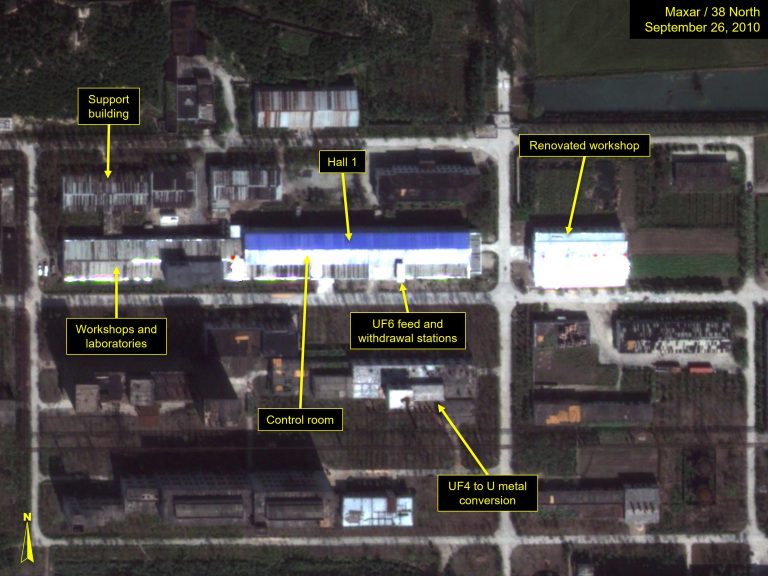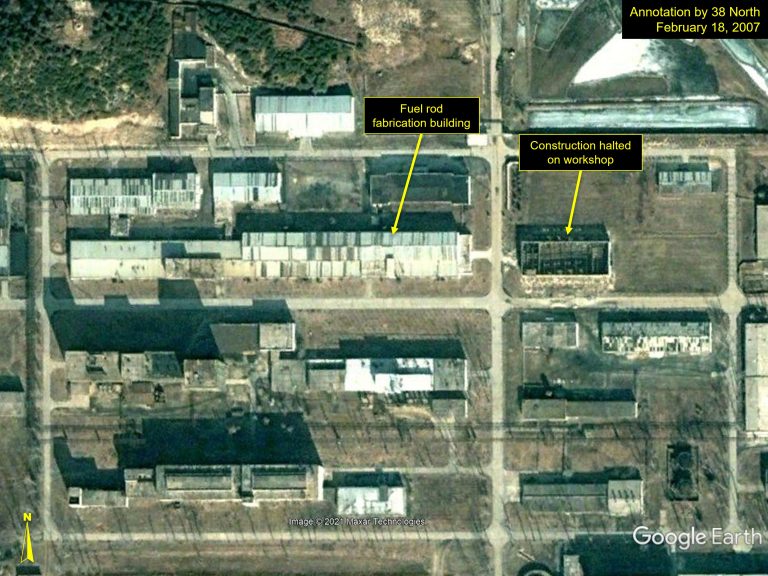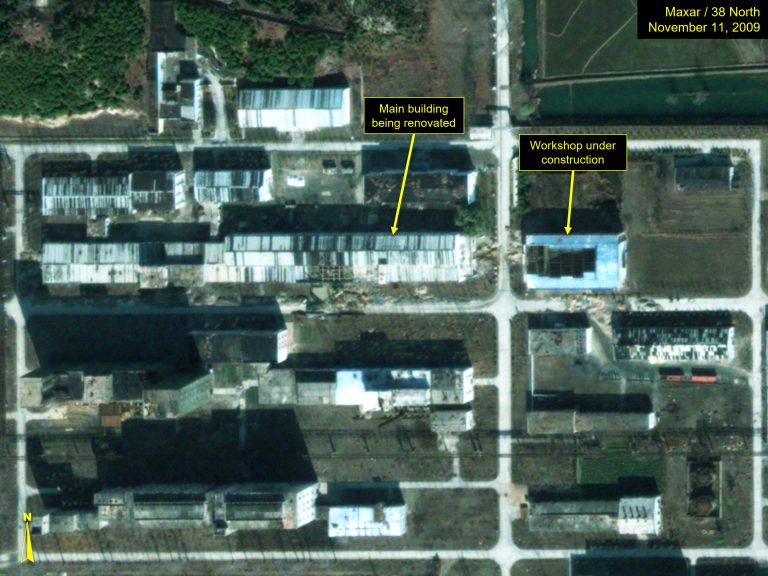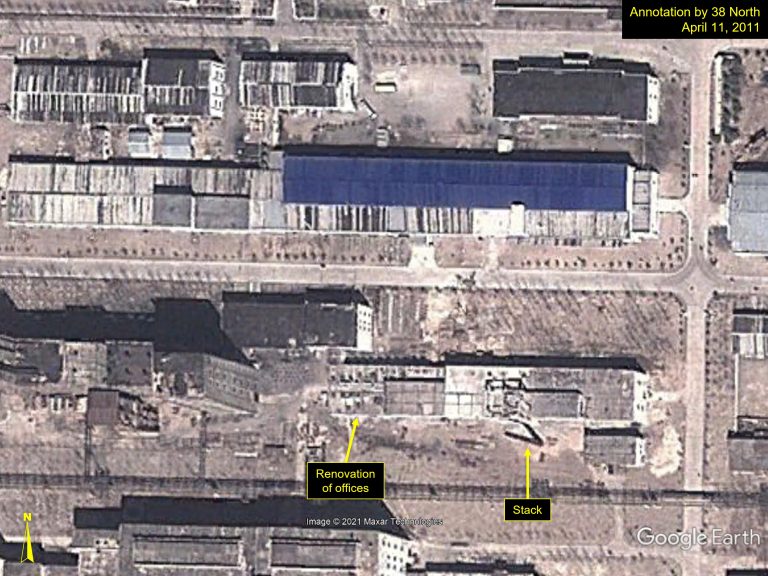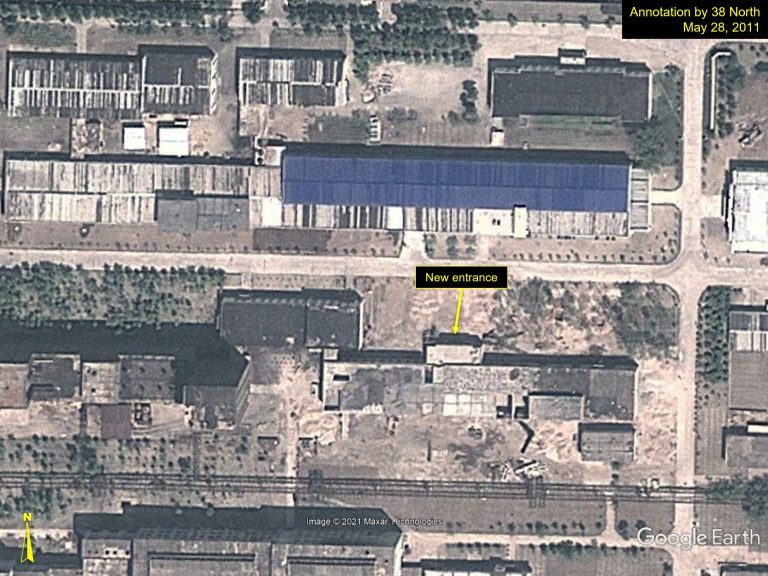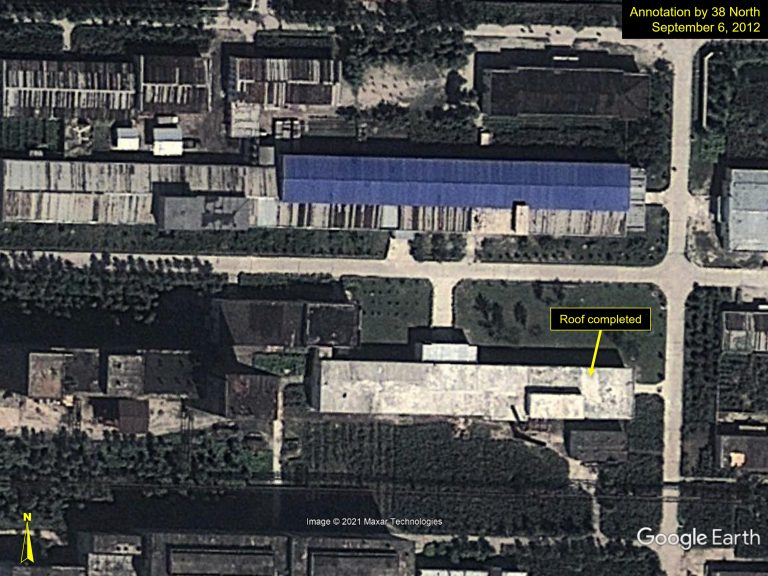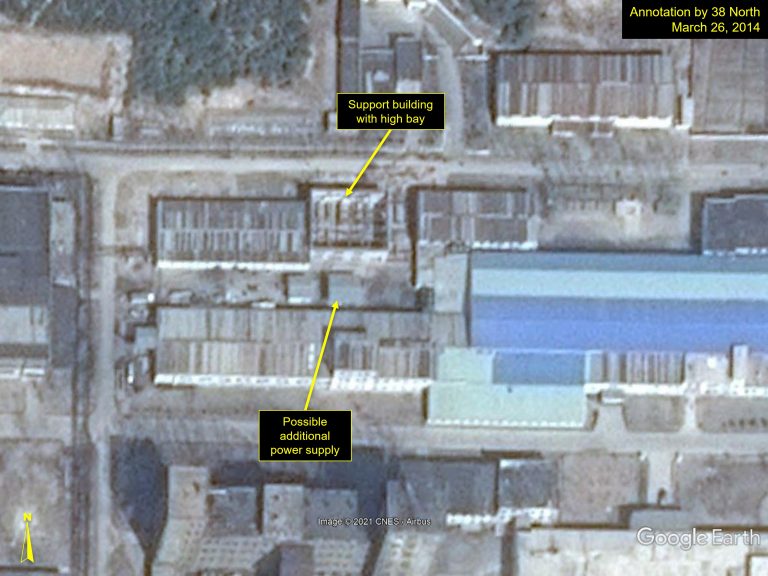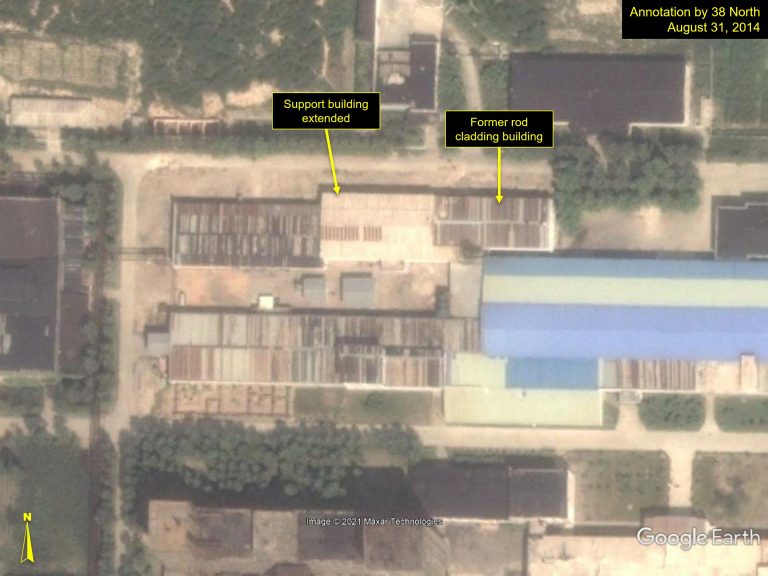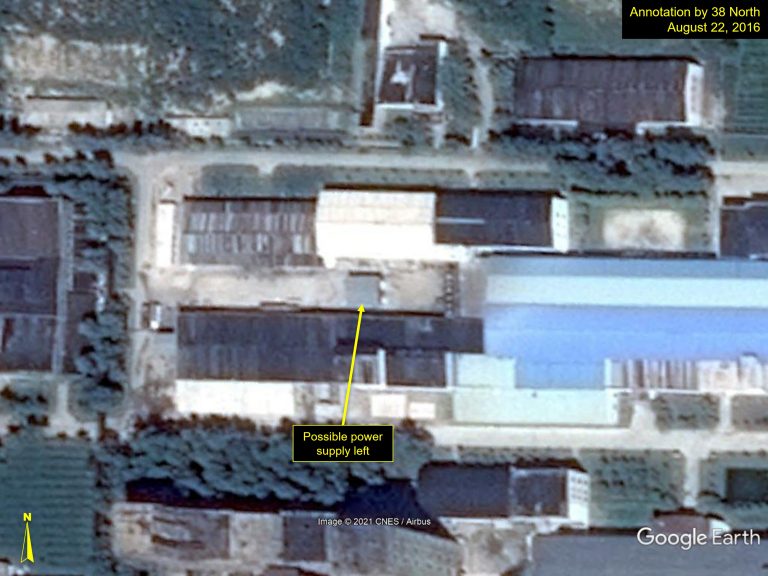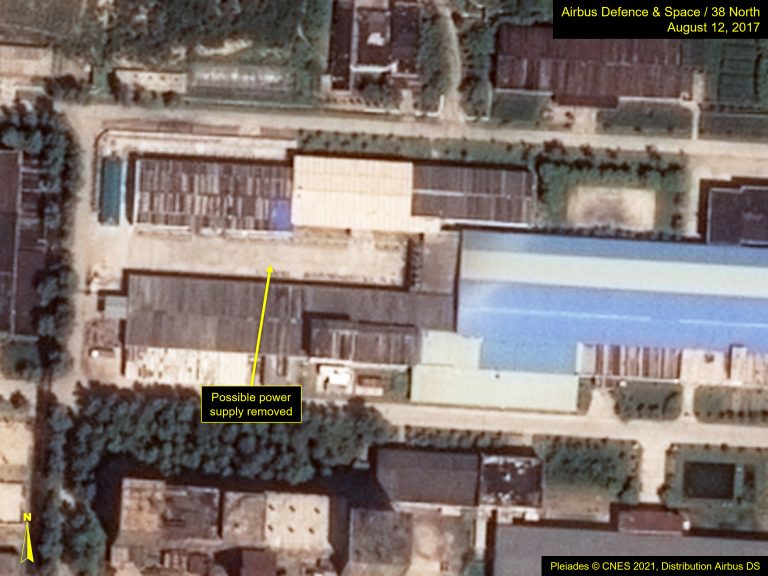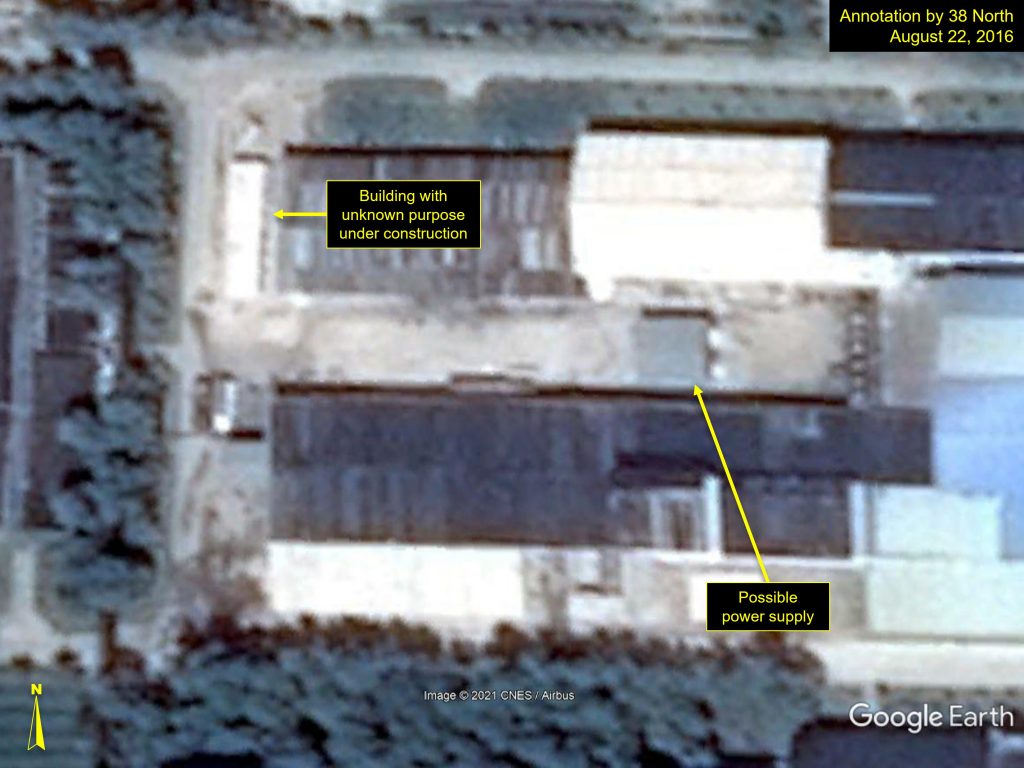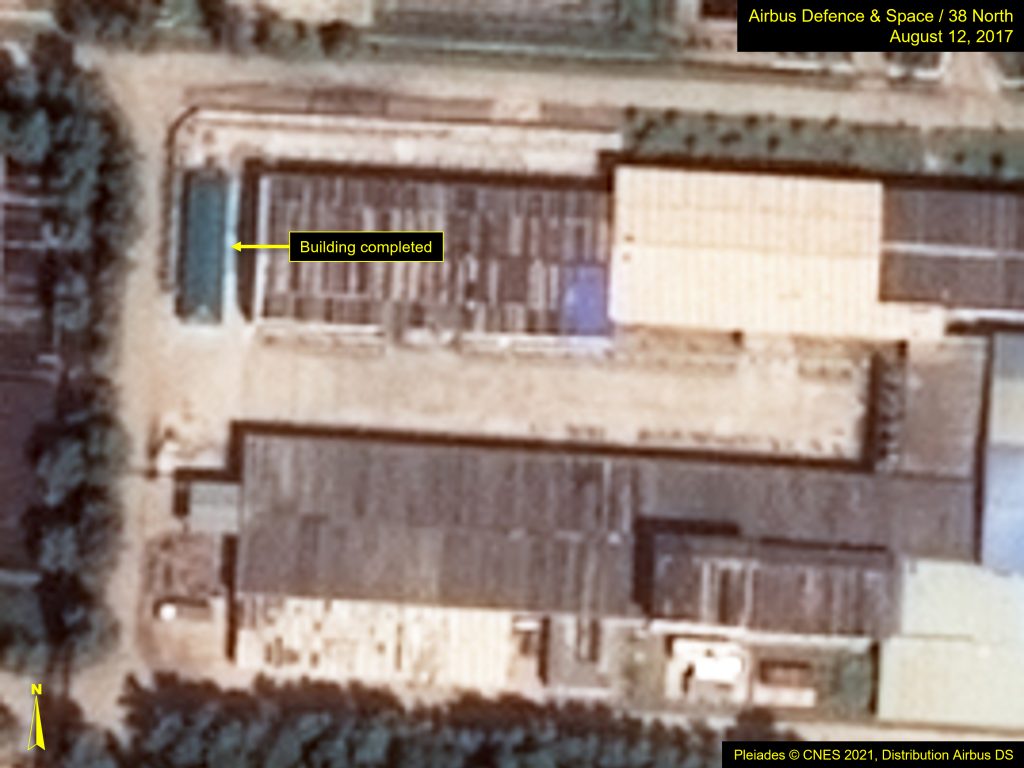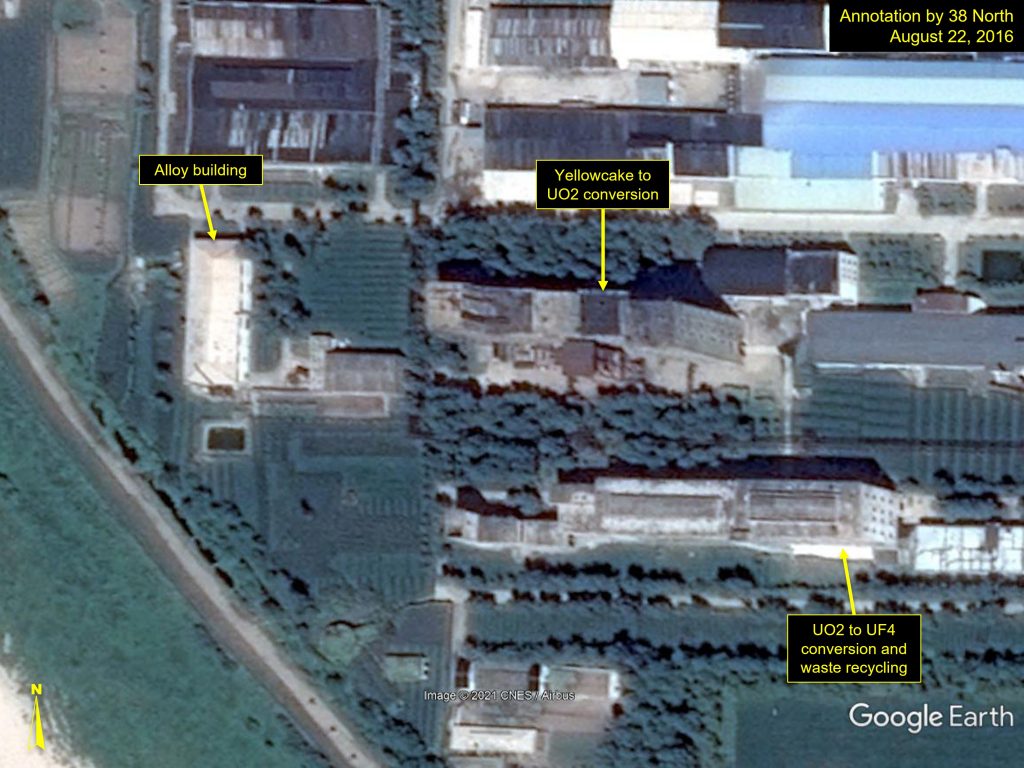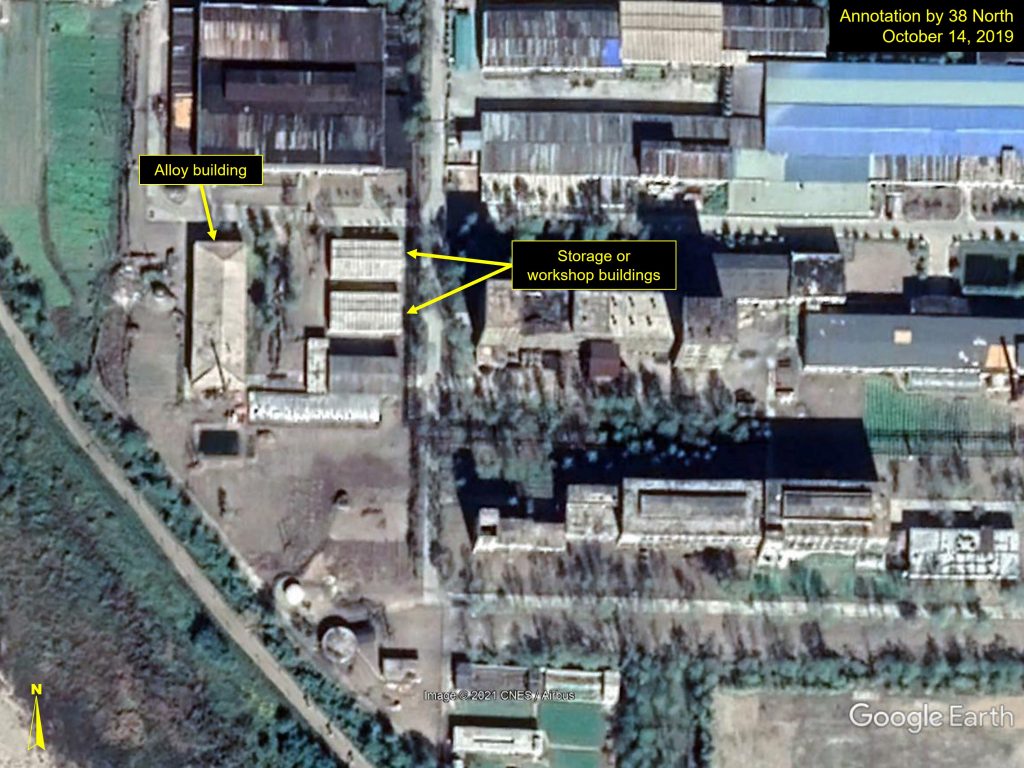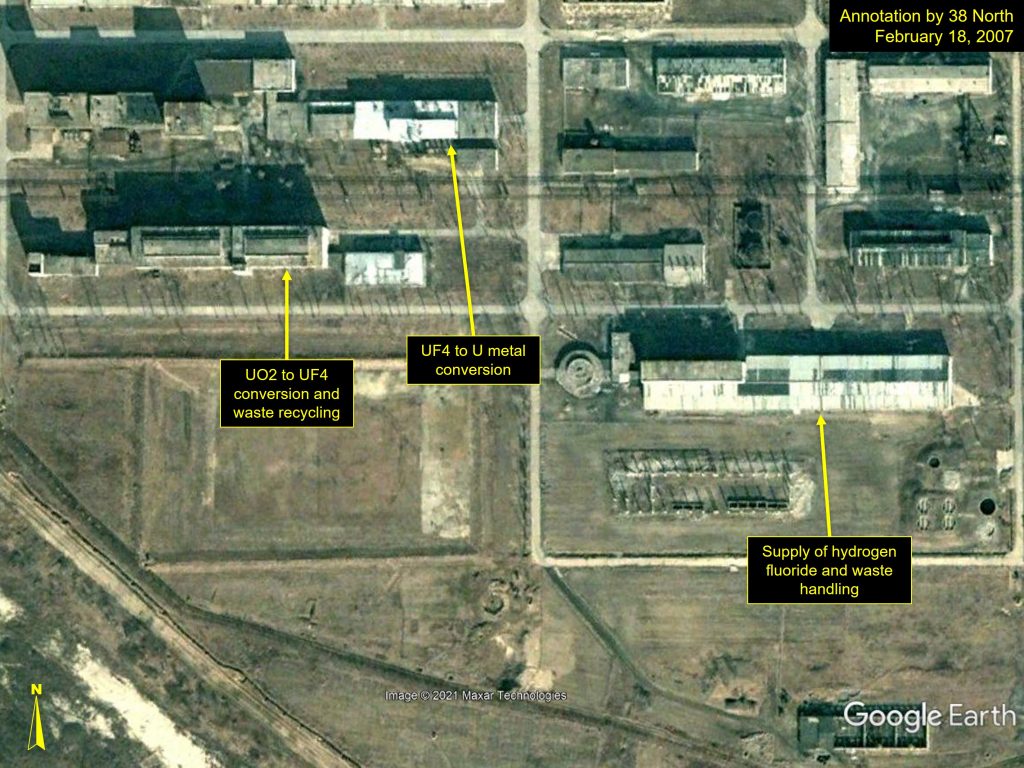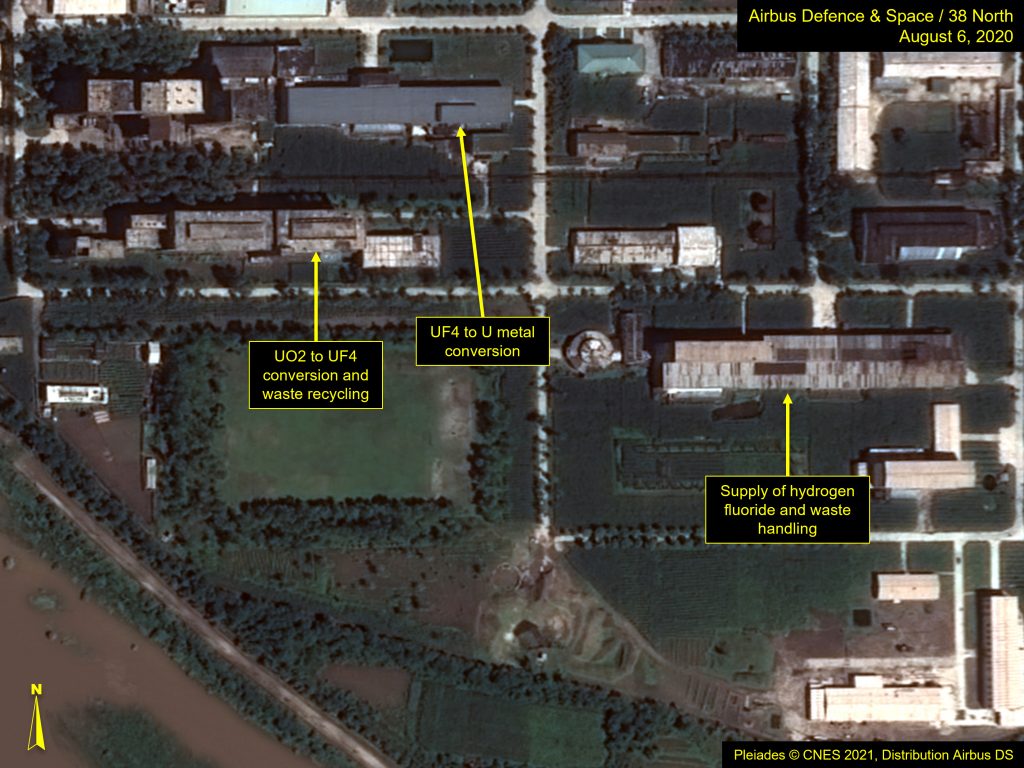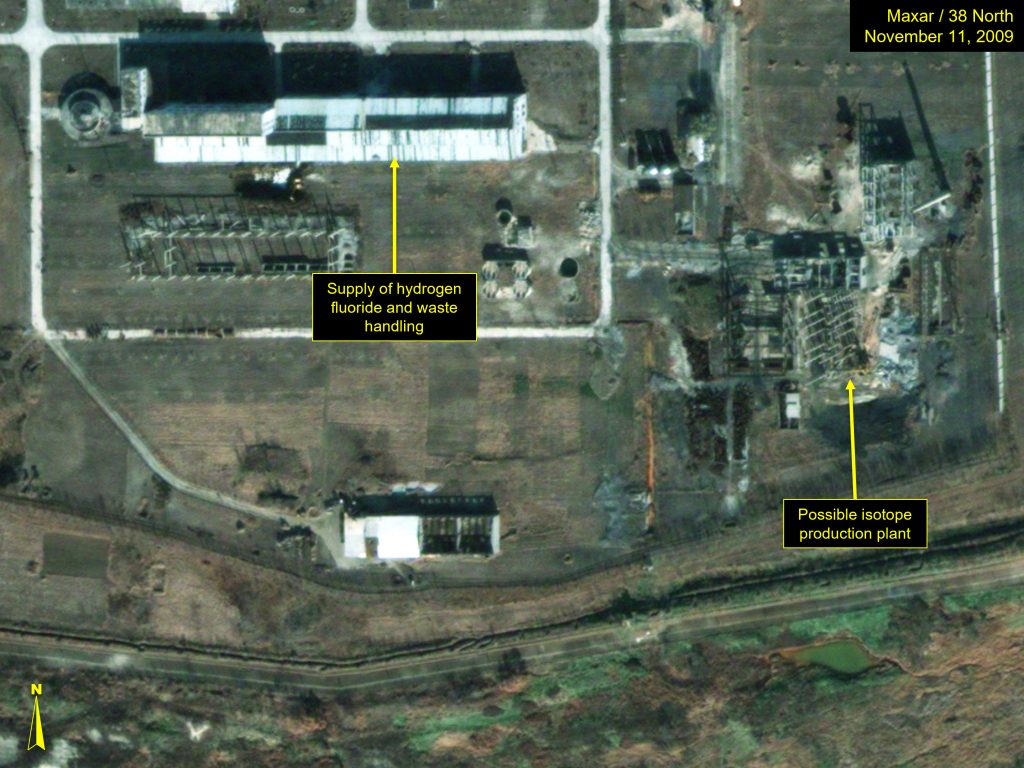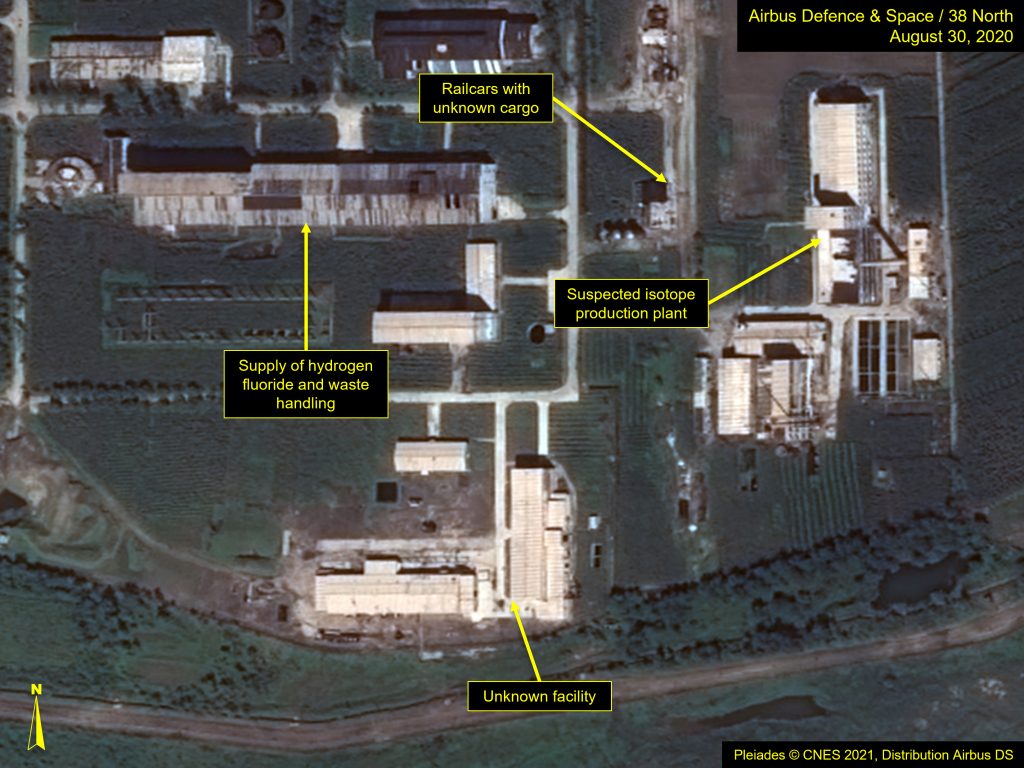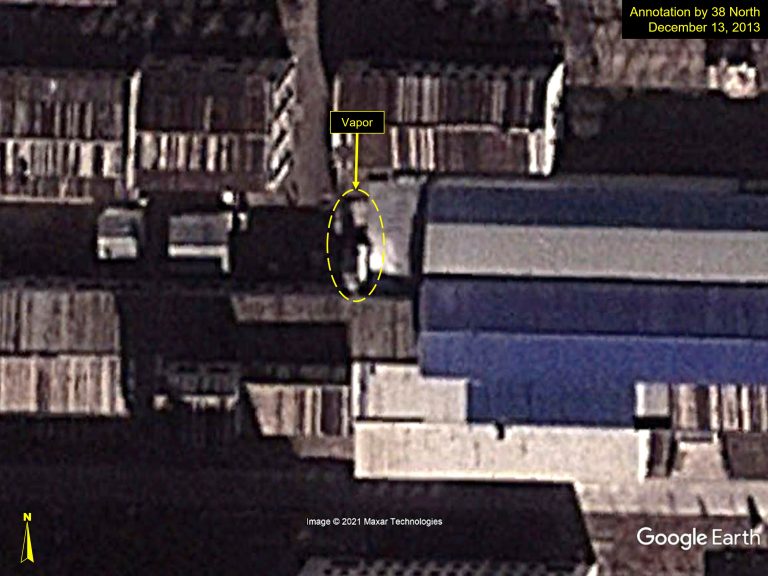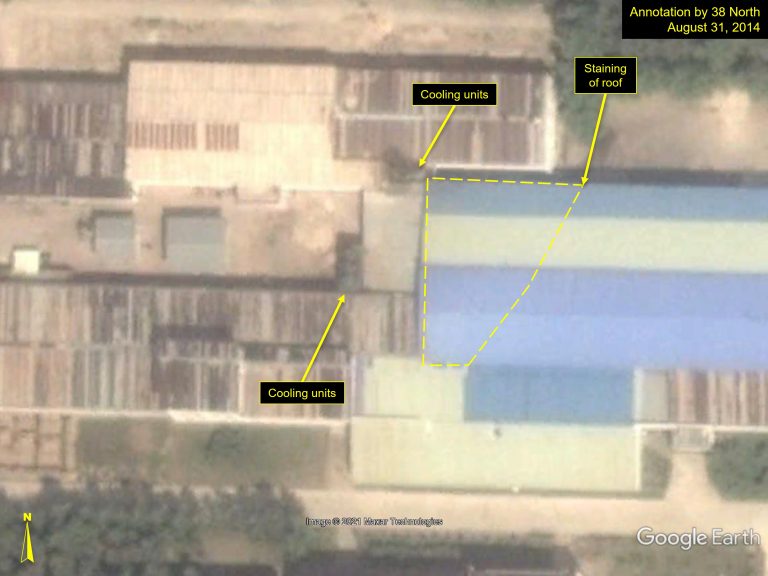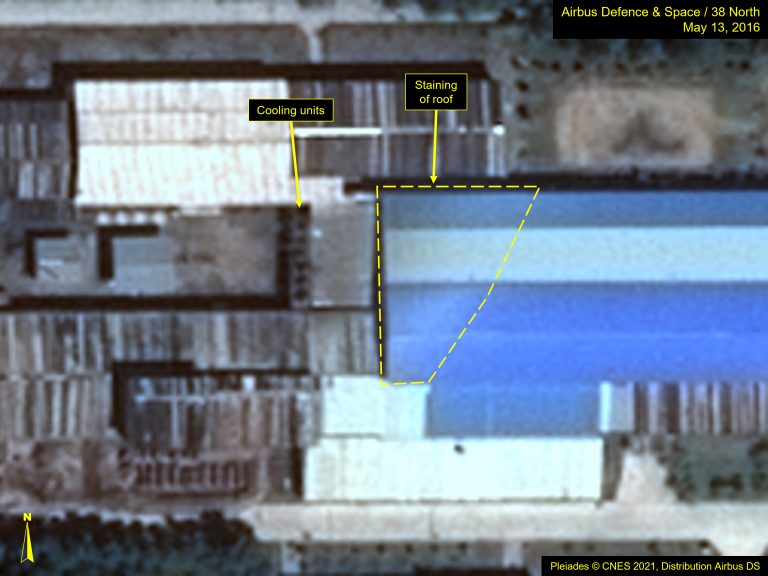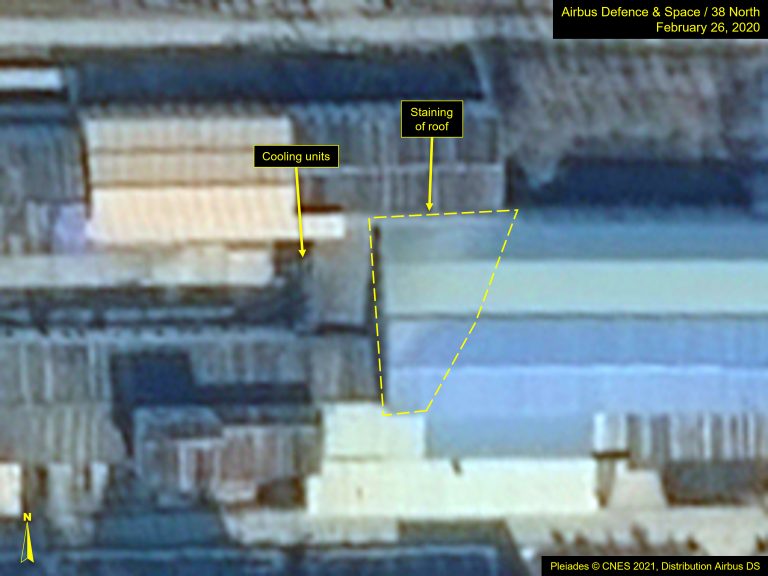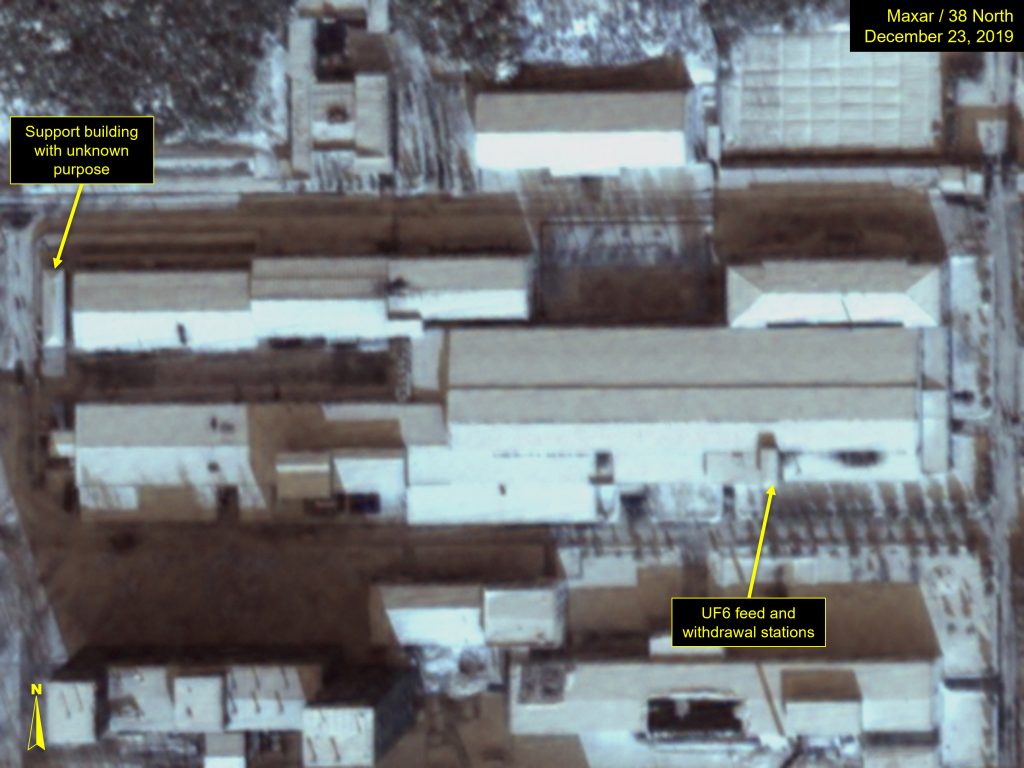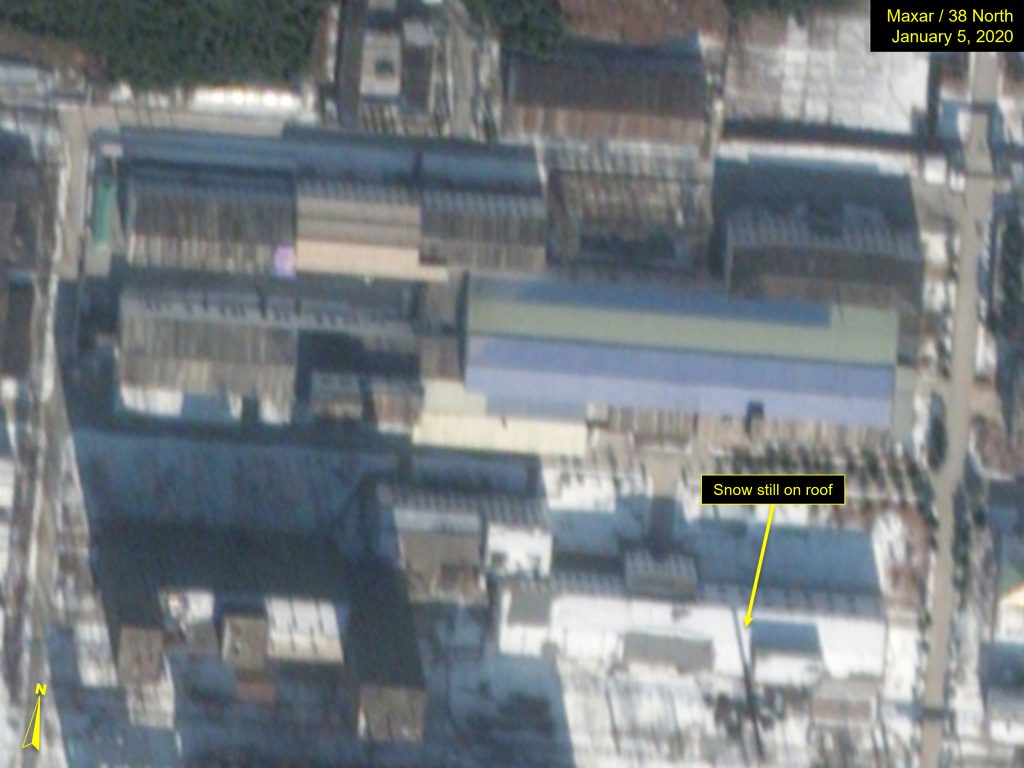Development of the Yongbyon Uranium Enrichment Plant Between 2009 and 2021
Understanding North Korea’s fissile material production capacity is an important factor in assessing the North’s ability to expand its nuclear weapons program. While the plutonium production reactors are easy to identify and monitor via commercial satellite imagery, the North’s uranium enrichment activities are much more difficult to discern, with both fewer unique attributes to the facilities and visible indicators of operations.
At the Eighth Congress of the Workers’ Party of Korea (WPK) held in January, Kim Jong Un disclosed goals for the North’s nuclear weapons program, including miniaturization of warheads, development of tactical weapons and a “super-large hydrogen bomb.” At the Supreme People’s Assembly meeting just weeks later, he highlighted the need to develop a nuclear power industry as well.
While none of these ambitions are new, there have been few corresponding advancements to North Korea’s capacity to produce plutonium and uranium in recent years—fissile materials needed for manufacturing nuclear weapons. In terms of plutonium production, the 5 MWe Reactor at the Yongbyon Nuclear Scientific Research Center, which is capable of producing up to six kilograms (kg) of plutonium per year, has not been operating since 2018 and the Experimental Light Water Reactor (ELWR), which uses low-enriched uranium fuel and may be able to produce additional plutonium in the future, has been under construction since 2011 and is still not complete. As for the uranium enrichment program, a Uranium Enrichment Plant (UEP) at Yongbyon was first revealed in 2010 and expanded in 2013 to2014, gradually increasing capacity as the installation of necessary infrastructure proceeded.
The UEP, which could have produced by the end of 2020 about 540 kg weapons-grade uranium, has become the backbone of North Korea’s ability to produce fissile material for nuclear weapons.[1] Its shutdown and dismantlement, as reportedly offered by Kim Jong Un at the Hanoi Summit in 2019, would be an important part of a denuclearization process, especially when coupled with its support facilities that produce feed material and uranium hexafluoride (UF6) and those used to manufacture new centrifuges.
History of North Korea’s Uranium Enrichment Efforts
North Korea started quietly pursuing a uranium enrichment production capability in the late 1980s. It wasn’t until April 2009 that Pyongyang announced it would “make a decision to build a light water reactor power plant and start the technological development for ensuring self-production of nuclear fuel as its first process without delay.”[2]
In 2002, Democratic People’s Republic of Korea (DPRK) officials acknowledged in their bilateral talks with the US the existence of a uranium enrichment program, but then denied the statement in August 2003. Little more was said about this until June 2009, when Pyongyang announced that uranium enrichment would commence on an experimental basis.[3] In September 2009, the DPRK mission to the United Nations (UN) issued a statement to the United Nations Security Council that “experimental uranium enrichment has successfully been conducted to enter into completion phase.”[4]
In August 2016, North Korea stated to Kyodo News it had been producing highly enriched uranium necessary for nuclear arms and power, but without providing information on quantities of enriched uranium or the locations of those activities.
The statements were made in conjunction with efforts to gradually adapt several buildings associated with the Fuel Rod Fabrication Plant at Yongbyon into what is now known as the Uranium Enrichment Plant.
Figure 1. Fuel Rod Fabrication Plant in 2007 after agreeing in February 2007 in the Six Party Talks to shut down the Yongbyon complex.
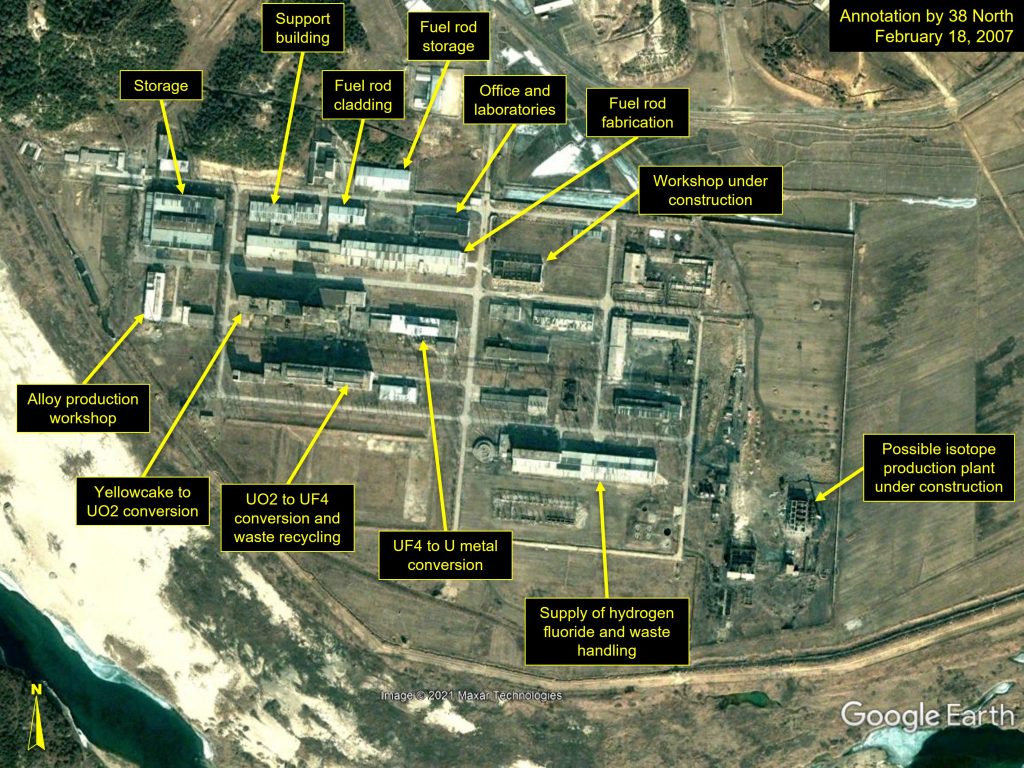
Key buildings of natural uranium metal fuel production for the 5 MWe and 50 MWe reactors included:
- Conversion of uranium ore concentrate (yellowcake) to uranium dioxide (UO2)
- Conversion of uranium dioxide to uranium tetrafluoride (UF4)
- Supply of hydrogen fluoride for the UO2 to UF4 conversion process
- Conversion of uranium tetrafluoride to uranium metal
- Fabrication of fuel rods
- Cladding of fuel rods
- Supply of magnesium alloys for fuel rods
- Storing of fuel rod cores and final fuel rods
Figure 2. The Uranium Enrichment Plant and its support buildings after renovations and additional construction in June 2021.
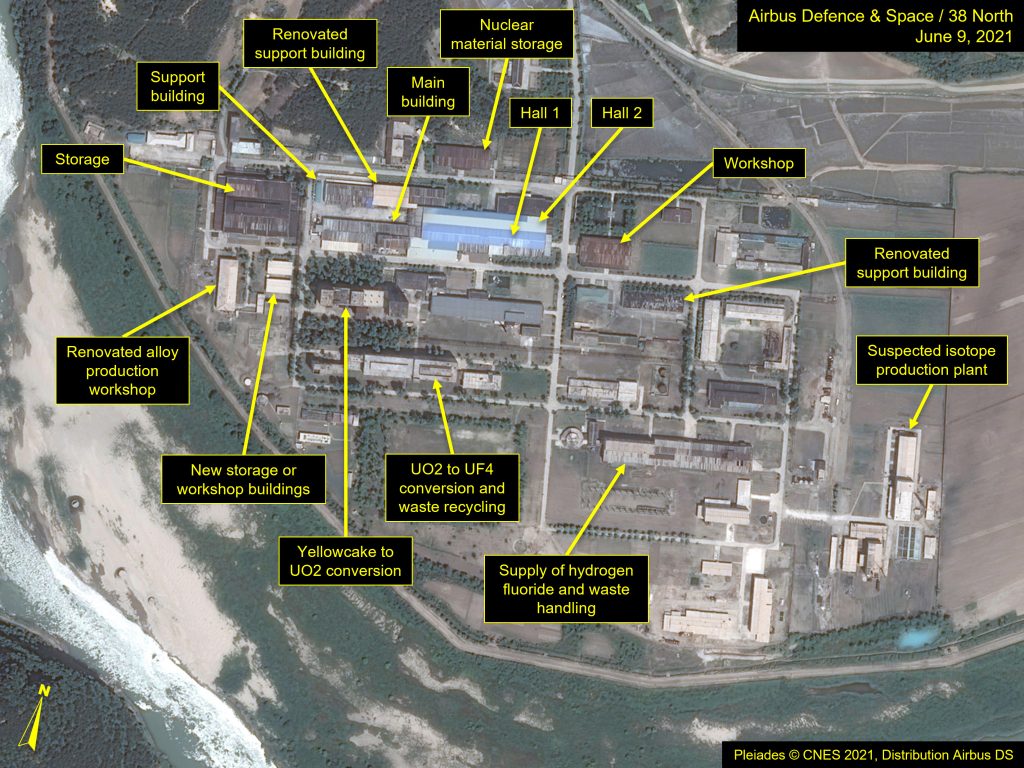
Construction of Centrifuge Halls
A production-scale uranium enrichment plant requires a large enrichment hall and additional support buildings, which are typically collocated with the plant. Due to strict quality control parameters, centrifuges are normally not transported long distances but assembled and maintained at workshops on-site.
A site usually includes installations for pretreating assembled centrifuges, for the removal and decontamination of broken and aging centrifuges, and for the transfer of UF6 between cylinders—all activities that are usually conducted outside of the centrifuge hall buildings.[5]
The former Fuel Rod Fabrication Plant at Yongbyon has the necessary infrastructure to handle toxic and corrosives gases and uranium. Such buildings can be adapted with minor changes for uranium enrichment support activities. Commercial satellite imagery shows that substantial changes have taken place to the buildings associated with the Fuel Rod Fabrication Plant between 2009 and today, indicating the gradual repurposing of this facility (Figure 2).
The first such modifications took place soon after the International Atomic Energy Agency (IAEA) inspectors were expelled in April 2009 from Yongbyon. Starting that summer, parts of the old Fuel Rod Fabrication building were renovated. This began with the construction of a 120-by-15-meter hall, Hall 1, with a blue roof (Figure 3).
Construction on an adjacent workshop had started years earlier but stalled when the Agreed Framework was concluded in 1994, resuming again in 2009. Since the construction took place under existing roofs, satellite imagery did not reveal the layout of the buildings. However, the workshop does not appear to have the air conditioning system needed for the kind of clean air environment required for assembling and testing centrifuges, which likely takes place in the workshops on the main building.
Figure 3. Uranium Enrichment Plant Hall 1 and possible workshop from 2007-2010.
The UEP was later extended by constructing a second centrifuge hall, Hall 2. Imagery from June 10, 2013, reveals that Hall 2, which is similar in size to Hall 1, has three major sections: 9-by-15-meter, 93-by-15-meter and 18-by-15-meter sections (Figure 4). The layout of Hall 2 could be different from that of Hall 1, which was observed by a team from Stanford University led by Dr. Siegfried Hecker in November 2010. At that time, the North Korean hosts told the team that modification of the first hall had started in April 2009 and that it contained approximately 2,000 centrifuges. According to the trip report, they appeared to be similar to the Pakistani P-2 centrifuge design, which had been installed in six cascades resulting in a capacity of 8,000 separative work units (SWUs) per year. The Stanford team was also told that the installation was operational and configured to produce low-enriched uranium for the Experimental Light Water Reactor under construction at the Yongbyon site. Normally, North Korean engineers are precise in their language. Using the term “operational” versus operating would likely indicate that at the time of the US visit, centrifuges were not necessarily running.
Figure 4. Main building in June 2013 with Hall 1 and Hall 2 with a concrete floor divided into three sections.
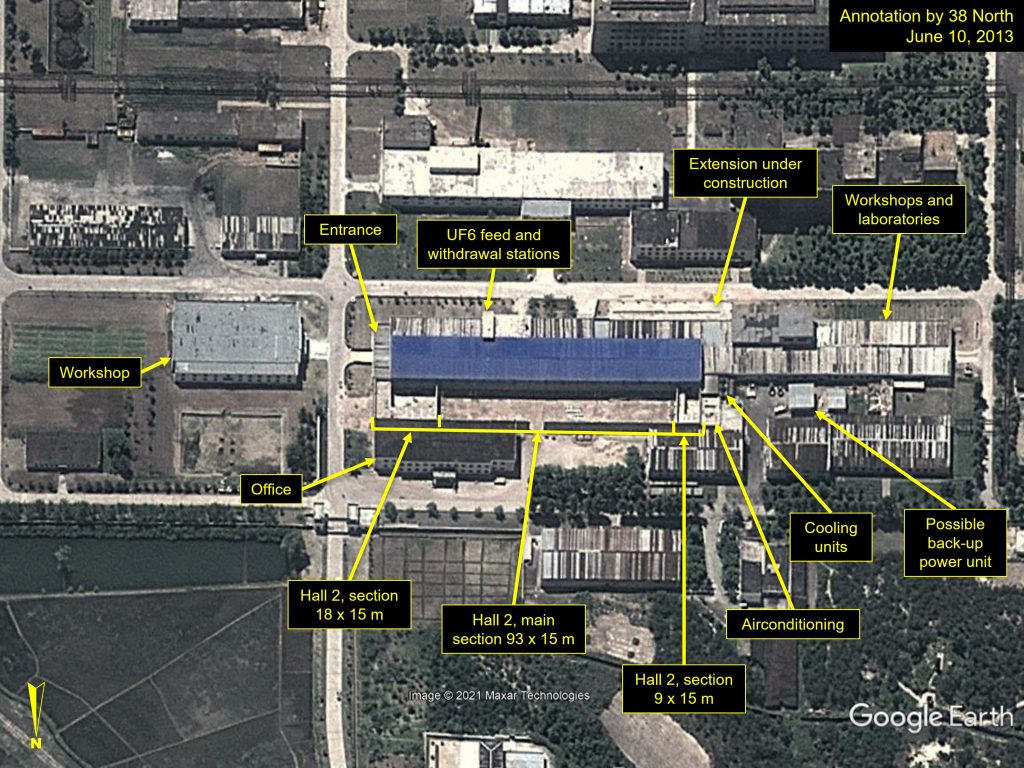
The Stanford team published its take on the design of the UEP based on the explanations provided during the facility tour (Figure 5). They estimated that cascade lines were approximately 50 meters long, and each of them had 330 centrifuges.
Figure 5. Layout of the enrichment Hall 1 in November 2010 as reported by the US team after its visit to Hall 1 section of the main building.
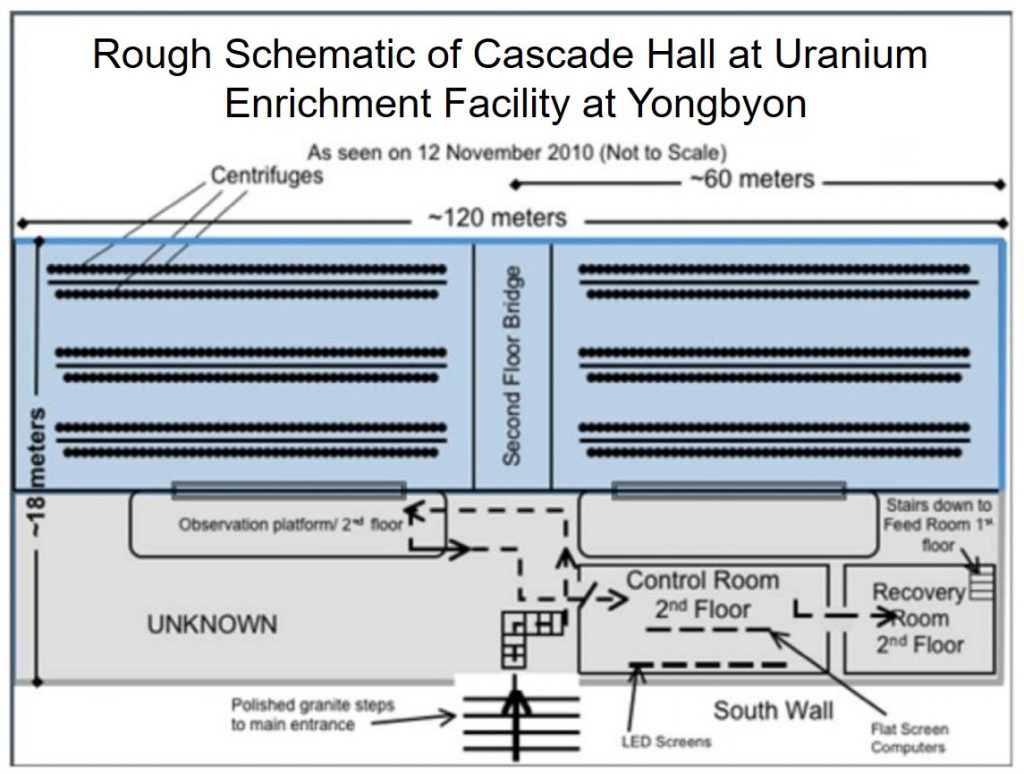
Since then, the North Koreans have stated that the plant was designed to enrich uranium for the ELWR. Therefore, one could expect the design of cascades in both centrifuge halls to be the same. However, the concrete floor of Hall 2 indicates that the main section of the hall is only 93 meters long when both Halls are 120 meters long. One possibility is that Hall 2 has fewer centrifuges or that the cascades in the main section of Hall 2 have a different configuration, such as installing the 25-centimeter-diameter P-2 centrifuges of a cascade in rows on base plates as is the case in Natanz (Figure 6).
Figure 6. Cascades of IR-2m centrifuges, which are similar in size to the P-2 centrifuges, in Natanz, Iran.
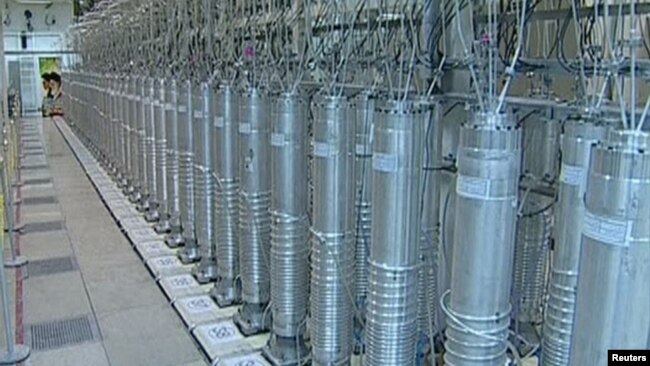
Assuming that 80 meters of the length of the main hall are used for cascades and centrifuges in cascades are installed in four rows, Hall 2 may be able to house six cascades, each of them containing 330 centrifuges. This would bring the total inventory of centrifuges at the UEP to 4,000. This arrangement would fit with the enrichment scheme of the A. Q. Khan network, where the first two cascade units have 2,000 centrifuges each and are producing the level of enrichment suitable for light water reactor fuel, or the low-enriched uranium is taken elsewhere for further enrichment to a higher level.
Figure 7. Cascade layout of A. Q. Khan for weapons-grade uranium production. Enrichment proceeds in four steps from natural uranium to 90 percent enrichment. Number of P-2 centrifuges for each cascade unit is presented in parentheses.
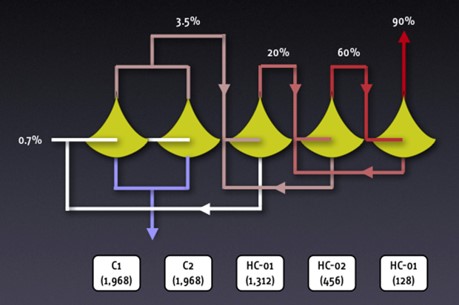
The smaller sections of Hall 2 reflected in Figure 4 could be used for the necessary assembling and balancing of centrifuges prior to the installation.
Both halls appear to have air conditioning units, which are essential to maintaining a clean environment and constant temperature. Air conditioning systems are located at the west end of the enrichment halls. Construction of the air handling system proceeded step by step. After completion of Hall 2, the cooling units were in different locations (Figure 8), and they were all moved to the same location by 2016 (Figure 9).
The air conditioning is also affecting the hall roofs. Staining has occurred over time due to the humidity and temperature of gases emitted by the cooling system, indicating the maintenance of an appropriate operational environment in the centrifuge halls over time. These observations could have two implications: 1) modifications of the air conditioning system could have required temporary suspension of enrichment; or 2) the staining just indicates that air conditioning has been operating, but does not confirm whether centrifuges are actually operating and uranium enrichment taking place.
Figure 8. Main building of the Uranium Enrichment Plant in September 2014.
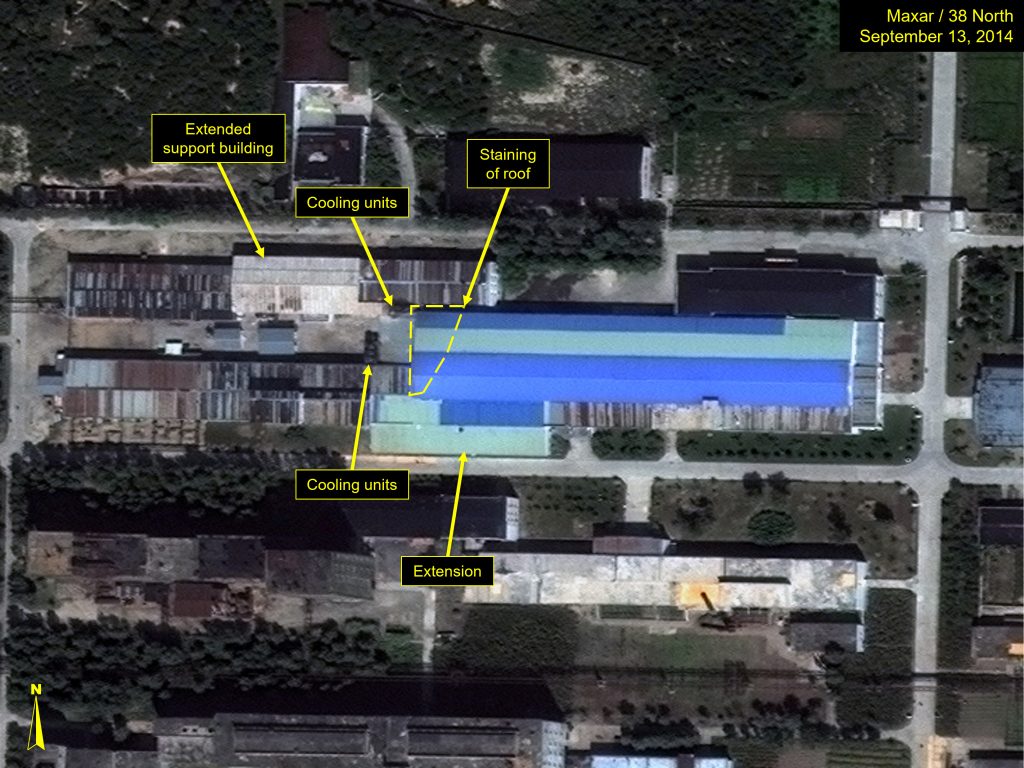
Figure 9. Main building of the Uranium Enrichment Plant in May 2016.
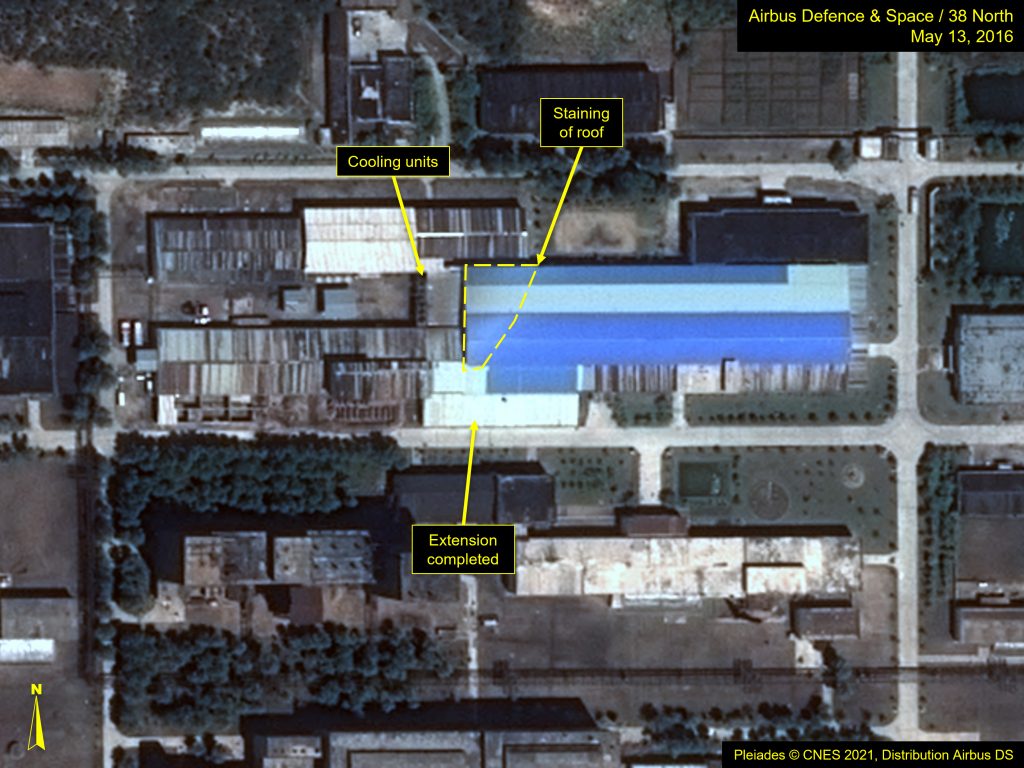
The Stanford team reported that the UF6 feed and withdrawal stations for Hall 1 were the elevated part of the facility (Figure 4 and Figure 5), but they did not provide any details on the design, such as types of UF6 cylinders used in autoclaves.
Since the design of the UEP is largely based on information obtained from Pakistan, the feed and withdrawal stations could be similar to those manufactured for the Libyan enrichment plant shown in Figure 10 for natural uranium and in Figure 11 for enriched uranium, which had two sets of feed and withdrawal stations: the larger autoclaves for 30B cylinders containing natural uranium, and smaller ones for 5A-type cylinders for highly enriched uranium.
The arrangement includes vacuum pumps to maintain low pressure in cascades with chemical traps, which would fit in the rooms adjacent to the actual feed and withdrawal stations. The old fuel fabrication building bay is high enough to accommodate such arrangements.
Figure 10. UF6 feed and withdrawal system for Libyan enrichment plant; manufactured in South Africa by a company involved with the A. Q. Khan Network.
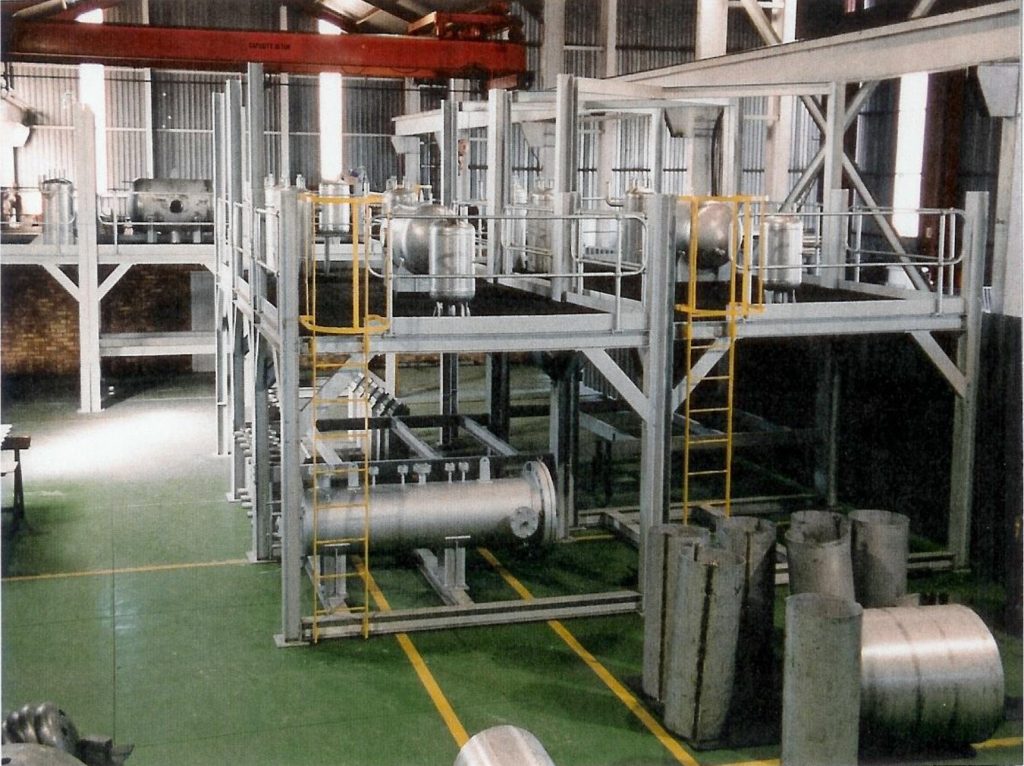
Figure 11. Small autoclaves for highly enriched uranium manufactured in South Africa for the Libyan enrichment plant.
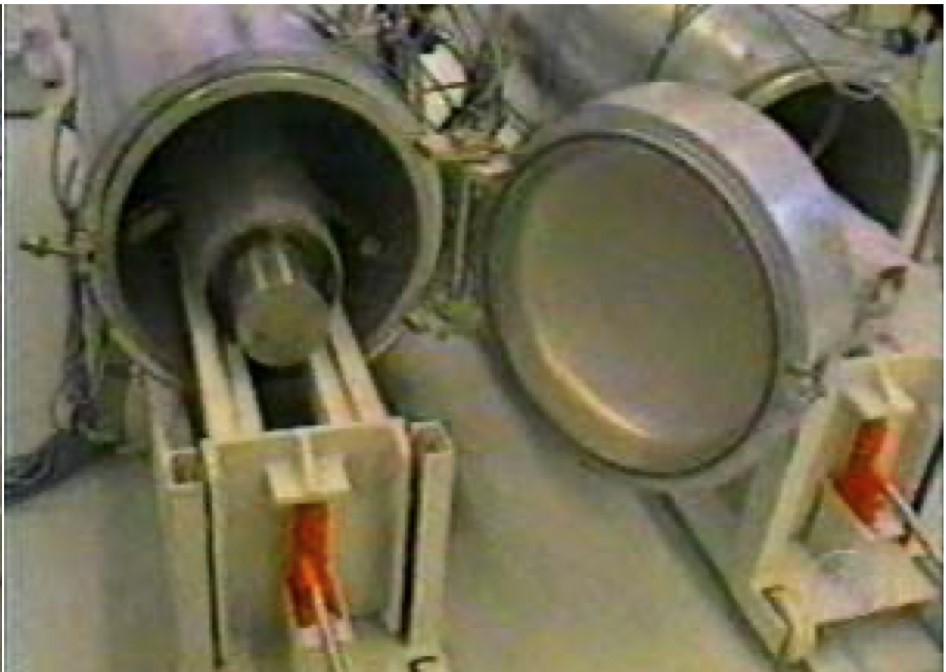
Figure 4 also shows construction starting in 2013 on an extension to the main building. By September 2014, the extension is seen with a blue roof (Figure 8). The former fuel fabrication building has additional workshops and laboratory space, which could be useful for handling and decontamination of removed centrifuges and other process equipment (Figure 4).
Building Support Infrastructure
Much of the public focus of the UEP at Yongbyon has been on the two cascade halls.
However, a review of the surrounding area starting from April 2009 reveals how North Korea converted several buildings of the former Fuel Rod Fabrication Plant to support the uranium enrichment program. Such an assessment also sheds light on the design of the cascade halls and the possible enrichment capacity of the UEP over time.
During 2011, the former uranium metal production building—where UF4 was converted to uranium metal in the past—was substantially renovated. Additional offices were built on the west end (Figure 12A), a new main entrance facing the enrichment halls was constructed (Figure 12B), and a new roof was completed (Figure 12C).
Due to past uranium conversion activities, this building has an emission gas handling system (which can be seen with a smokestack), making it suitable for handling toxic materials, including UF6 between cylinders and storing uranium-bearing wastes.
Figure 12. Renovation of the UF4 to uranium metal building.
Figure 13. Renovation of a support building and additional power supply.
It is also likely that the early operations took advantage of additional power supplies (Figure 13A). Units were then moved gradually as the renovation of a nearby support building proceeded. (Figure 13B, Figure 13C and Figure 13D). The renovated support building, which was also extended, has a high bay hall (Figure 13A).
A small additional building with an unknown purpose was constructed in late 2016 (Figure 14A) and completed by August 2017 (Figure 14B).
Figure 14. Renovation of building with unknown purpose.
Left: Image Google Earth, annotation by 38 North. For media licensing options, please contact [email protected]. Right: Image Pleiades © CNES 2021, Distribution Airbus DS. For media options, please contact [email protected].
Figure 15. Overview of alloy workshop.
Images: Google Earth, annotation by 38 North. For media licensing options, please contact [email protected].
The building where magnesium alloys were treated for 5 MWe and 50 MWe reactor fuel has also been renovated (Figure 15A), and two new buildings have been added to the location (Figure 15B) in recent years. It is not clear whether these buildings are now associated with the UEP or used to produce alloys for 5 MWe Reactor or ELWR fuels.
Imagery from August 2009 and June 2021 does not indicate any substantial renovation of buildings associated with the conversion of yellowcake to UO2 (Figure 16A and Figure 16B). Process steps to produce first UF4 and then UF6 require additional space and removal of older process equipment; however, no corresponding construction work has been observed.
Figure 16. Uranium conversion area buildings.
Left: Image Google Earth, annotation by 38 North. For media licensing options, please contact [email protected]. Right: Image Pleiades © CNES 2021, Distribution Airbus DS. For media options, please contact [email protected].
The southeastern corner of the site has been developed substantially since April 2009, when North Korea suspended the implementation of measures that had been agreed to in Six Party Talks (Figure 17A and Figure 17B). This includes a suspected Isotope Production Plant (IPP, or Radioisotope Production Plant) and an unknown facility.
Figure 17. Construction of possible Isotope Production Plant.
Left: Satellite image © 2021 Maxar Technologies. All rights reserved. For media licensing options, please contact [email protected]. Right: Image Pleiades © CNES 2021, Distribution Airbus DS. For media options, please contact [email protected].
Railcars with unknown cargo occasionally appear on the eastern side of the site (Figure 17B) and at the Radiochemical Laboratory. Available imagery has not revealed which facility receives or ships material in those containers.
Production of Enriched UF6 at the UEP
There are several indicators that can be used to estimate the amount of enriched uranium produced by the UEP. However, at the same time, there are limitations and uncertainties associated with the approach. The limitations include the lack of knowledge about the actual performance of centrifuges, cascade set-up in both enrichment halls, operational history of the facility as well as the source of required feed material, natural uranium hexafluoride, UF6. Until facts are verified on the ground, two possible production scenarios include: 1) low-enriched uranium is being produced for the ELWR as stated by the North Koreans in 2010; or 2) high-enriched weapons grade-uranium hexafluoride is being produced using 4,000 centrifuges with a capacity of four SWU/year each.
Such an approach can be used to set an upper limit for enriched uranium produced until the end of 2020, if based on the expected availability of cascade units able to operate starting for Hall 1 in 2012 and for Hall 2 in 2015. Using that assumption, each UEP cascade hall, in ideal circumstances, would be able to produce about 2.2 tons per year of uranium enriched to 3.5 percent U-235 or 47 kg per year enriched to 90 percent U-235 (weights in uranium); the latter would be enough for two crude nuclear devices.
Figure 18. Overview of cooling units near Hall 1 and Hall 2 of the main building since 2013.
Since 2010, imagery has indicated that temperatures in centrifuge halls have probably been continuously controlled. This can be seen from the cooling units’ release of vapor at low temperatures (Figure 18A) and the increase of staining of roofs next to those units over time (Figure 18B, Figure 18C and Figure 18D).
It is worth noting that some of the cooling units were moved from their original location (Figure 18A) to a single bank (Figure 18D), which may have periodically interrupted operations at Hall 2 between 2013 and 2019. In addition, some of the cooling units have recently been temporarily removed for maintenance.
It is very likely that the operators want to keep the air conditioning system running to maintain appropriate temperatures and to clean air in the cascade hall regardless of whether actual uranium enrichment is taking place. However, another sign of operation is the melting of snow on the roof of the main enrichment building. The melting of snow above the UF6 feed and withdrawal stations, as well as on support buildings possibly handling nuclear material, is also an indication that actual enrichment was taking at that time since the feed stations only need to be heated when the plant is operating (Figure 19).
Figure 19. Before and after snow melting on the roofs of the main and supporting buildings.
Satellite images © 2021 Maxar Technologies. All rights reserved. For media licensing options, please contact [email protected].
From the developments described above, Hall 1 should have been able to start enrichment gradually in 2012, and Hall 2 in 2015 when installation of centrifuges and necessary infrastructure had been fully completed. By the end of 2020, the UEP could have produced up to 33 tons of uranium enriched up to 3.5 percent U-235 or approximately 705 kg of uranium enriched up to 90 percent U-235 (weights in metal). Stocks of enriched uranium could, however, be lower for a number of reasons.
To fully utilize the estimated enrichment capacity of 16,000 SWU/year, the UEP should receive annually, depending on the scenario, approximatively 20 to 30 30B-type UF6 cylinders and ship out a similar number of depleted uranium cylinders.[6] If the UEP had run with a full enrichment capacity, there should have been 300 to 400 UF6 cylinder transfers after 2012. However, no such transfers have been observed in the imagery analyzed for this report or reported in open sources, which could mean that enriched uranium stocks are actually lower. Customarily, such cylinders are stored at commercial facilities in the open air, but North Korea may have decided to conceal production activities.
There is also a report stating that UF6 is produced in the building that was originally designed to convert yellowcake to uranium dioxide. However, imagery available between 2007 and today does not reflect such modifications, which would have been substantial, to the building. Imagery has not revealed any transfer of UF6 cylinders between that building and centrifuge halls either.
Another element that would be expected at an active enrichment operation is the regular replacement of centrifuge rotors. If the lifetime of a centrifuge is 10 to 20 years, every year, five to10 percent of them, or 200 to 400 centrifuges, would need to be replaced. That would mean movement of several containers in the UEP area. While there are large time gaps between available imagery, no such movements have been observed or been reported in open sources, indicating that the facility may not have been operating with its estimated full capacity.
In 2010, the North Koreans explained that the UEP is used to produce enriched uranium for the ELWR, which requires an initial core load of 4.0 tons of UO2. Assuming that they use the UEP to support both the ELWR and weapons program, and that they reserved the eight tons of UO2 needed for the initial core and first core reloadings, as well as necessary manufacturing experiments requiring eight tons of UO2, there would have been capacity to produce close to 540 kg of uranium (metal weight) enriched up to 90 percent U-235, or approximately 20 or so weapons, depending on how much HEU is used per weapon.
Noting the changes made to the cascade halls of the UEP after 2011, the lack of sighting of UF6 containers and replacement centrifuge transfers may indicate that the quantity of enriched uranium produced is less.
What Is Known About Other Possible Uranium Enrichment Plants?
Estimates vary widely about the size of North Korea’s nuclear arsenal. A recent RAND/ASAN report estimated that North Korea could have had as many as 67 to 116 nuclear weapons in 2020, and depending on the development scenario, may have as many as 151 to 252 nuclear warheads by 2027. These are much higher figures than, for example, estimates by SIPRI, which puts the arsenal at only 40 to 50 nuclear warheads in January 2021.
These assessments all use different metrics, which makes comparisons difficult. RAND/ASAN bases its estimate on 20 kg of highly enriched uranium per weapon, whereas Siegfried Hecker, for instance, uses 25 kg and David Albright uses 27 kg.[7] However, given the potential for different designs, it is more important to have an accurate assessment of North Korea’s highly enriched uranium stocks rather than the number of bombs.
In this context, it is essential to look at the variance in assumptions about North Korea’s uranium enrichment capabilities. The RAND/ASAN report assumes that North Korea could have three uranium enrichment plants outside of Yongbyon: 8,000 centrifuges in Kangson, 10,000 centrifuges in Bungang, and an unknown number at Sowi-ri.[8] Together, they estimate these four plants (including the UEP at Yongbyon) have a total combined enrichment capacity of 80,000 SWU/year. However, a recent study of Kangson shows it does not have the features of an enrichment plant of that size; doubts have also been expressed by Dr. Hecker. Bungang is also a suspected facility in the Yongbyon area, but studies of underground facilities in that area do not have features typical of uranium enrichment facilities either.
Moreover, when we look at the receipts from the acquisition of uranium enrichment technology and relevant equipment from Pakistan and elsewhere, North Korea should have been able to establish a uranium demonstration plant by 2005 if it confronted no major obstacles. That should have been preceded by extensive research and development (R&D) in a location, which remains unknown. Such a demonstration plant would typically have 1,000 to 2,000 centrifuges and be likely designed to produce both 3.5 percent enriched and 90 percent enriched uranium. It may also be used to develop more advanced centrifuges.
Alternatively, this and other potential plants outside of Yongbyon may not have duplicate capabilities to the UEP at Yongbyon. Instead, they may be used to produce only highly enriched uranium, fed by low-enriched uranium from the UEP. There is no public confirmation of such an arrangement, but judging from the stepwise uranium enrichment scheme provided by A. Q. Khan, it would be a logical division of labor. Such a facility, capable of providing 150 to160 kg of highly enriched uranium annually, would have a fairly small footprint, similar to the underground facility in Fordow, Iran, which was originally designed to produce highly enriched uranium.
Furthermore, there are other constraints that limit North Korea’s uranium enrichment capacity, such as the procurement of key materials and components. Like many countries, North Korea is still likely dependent on clandestine sources in acquiring them, despite efforts to be self-sufficient. This includes items like machine tools, special fast-acting valves, maraging steel and carbon fiber, which are all subject to strict export controls. However, there are few signs that North Korea has been successful in acquiring them in larger quantities. Albright lists a couple of possible cases, but the UN Security Council Panel of Experts has not reported substantial breaches since the adoption of Resolution 1718, which bans the provision to and the procurement by North Korea of nuclear-related items.[9]
Conclusion
Since the expulsion of IAEA inspectors from Yongbyon in April 2009, North Korea has renovated the former Fuel Rod Fabrication Plant into a Uranium Enrichment Plant, along with a full support infrastructure. Since the North’s 5 MWe Reactor has not run since 2018 and the ELWR is still unfinished, the UEP appears to now serve as the backbone of the country’s fissile material production program. With the gradual ramping up of enrichment at the UEP and assuming that part of the enrichment effort has been devoted for the needs of the ELWR, the Yongbyon facility would have produced by the end of 2020 close to 540 kg of uranium (metal weight) enriched up to 90 percent U-235.[10]
While there is wide speculation North Korea has multiple additional enrichment facilities outside of Yongbyon, there is not enough information—such as procurement records and probable access to critical materials—to be confident beyond one pilot or demonstration plant. Even in that case, it is unlikely that it duplicates the capabilities of the UEP. A more probable scenario is that low-enriched uranium is produced at Yongbyon, some of which is used for reactor fuel and the rest sent to an outside facility to enrich up to weapons grade. Based on available information, annual production of weapons-grade uranium with the UEP and one possible additional suspected enrichment plant is likely around 150 to160 kg of highly enriched uranium, or material enough for half a dozen implosion devices with uranium cores.
North Korea reportedly offered at the 2019 Hanoi Summit to close all of Yongbyon as the first step towards denuclearization. This would have included the dismantling of the UEP, 5 MWe Reactor and the reprocessing plant, key facilities in Yongbyon to produce fissile material, and prevent the finishing of the ELWR. It would have been an important first confidence building step in the denuclearization process, greatly diminishing the country’s fissile material production capabilities, and limiting how much the nuclear weapons arsenal could expand.
These efforts would be significant, especially if coupled with the suspension and eventual dismantlement of uranium hexafluoride production, production of manufactured centrifuges and their key components, and uranium enrichment R&D. However, complete dismantlement of the UEP and UF6 conversion facility should not take place before the historical production of nuclear material at these facilities has been verified to ensure that information is not irretrievably lost before conclusions have been drawn.
- [1]
This is the author’s estimate based on the separative work units (SWUs) available as the UEP is being built.
- [2]
“UNSC Urged to Retract Anti-DPRK Steps,” KCNA, April 29, 2009.
- [3]
“DPRK Foreign Ministry Declares Strong Counter-Measures against UNSC’s ‘Resolution 1874,’” KCNA, June 13, 2009.
- [4]
“DPRK Permanent Representative Sends Letter to President of UNSC,” KCNA, September 4, 2009.
- [5]
Pretreatment and passivation of assembled centrifuges with UF6 gas are required to reduce corrosion. It is done before centrifuges are installed into cascades.
- [6]
The use of 30B cylinders is based on the assumption that for this facility, similar feed, and withdrawal arrangements apply to the facility designed for Libya. If North Korea has opted for bulkier type 48Y cylinders, the annual number of receipts and shipments would be three to five cylinders, respectively. According to procurement information, North Korea has acquired 30B cylinders or equivalent from foreign sources.
- [7]
The author has converted parameters from the publications of the authors to the same unit, kilograms of uranium metal enriched above 90 percent U-235.
- [8]
Sowi-ri has been mentioned by several authors based on a South Korean news media report. See: Larry A. Niksch, “North Korea’s Nuclear Weapons Development and Diplomacy,” Congressional Research Service, January 5, 2010, https://fas.org/sgp/crs/nuke/RL33590.pdf; and “NK Has Built Uranium Enrichment Facilities,” Dong-a Ilbo, February 18, 2009, https://www.donga.com/en/article/all/20090218/261399.
- [9]
See: United Nations, Security Council, Resolution 1718 (2006), S/RES/1718, October 14, 2006, https://www.undocs.org/S/RES/1718%20(2006); and reports of the UN Panel of Experts, which can be found at https://www.un.org/securitycouncil/sanctions/1718/panel_experts/rerorts.
- [10]
Recent IAEA reports in 2021 state that the UEP is not (currently) enriching uranium. See also: Rafael Mariano Grossi, “IAEA Director General’s Introductory Statement to the Board of Governors,” IAEA, June 7, 2021, https://www.iaea.org/iaea-director-generals-introductory-statement-to-the-board-of-governors-7-june-2021.

